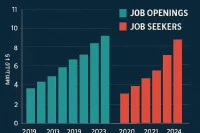China’s semiconductor industry is stepping up efforts to reduce its reliance on U.S. chip giant Nvidia, with plans to triple domestic production of artificial intelligence (AI) chips by 2026, according to a Financial Times report on Wednesday.
The report, citing people familiar with the matter, said Huawei Technologies Co. aims to begin AI chip production at a plant before the end of this year, with two additional facilities expected to come online in 2025. Combined, the output from these three plants could outpace the current production capacity of China’s largest chip maker, Semiconductor Manufacturing International Corp. (SMIC).
Huawei reportedly plans for these plants to produce chips specifically designed to support its own business operations. However, the ownership structure of the plants remains unclear. When asked by the Financial Times, Huawei denied that it had any plans to operate its own plants, leaving questions about whether state-backed partners or joint ventures will ultimately run the facilities.
Neither Huawei nor SMIC immediately responded to Reuters requests for comment on the report.
Beijing Accelerates Domestic AI Chip Development
The push reflects Beijing’s urgency in building domestic alternatives to Nvidia’s advanced processors, which dominate global AI development. Washington has imposed strict export controls that bar Nvidia and other U.S. chipmakers from selling their most powerful semiconductors to Chinese firms over national security concerns.
To fill the gap, Chinese companies are racing to build homegrown solutions. According to the report, SMIC plans to double its manufacturing capacity for 7-nanometer chips in 2025, with Huawei as its largest customer. The 7nm node is still generations behind the cutting-edge 3nm and 5nm chips produced by Taiwan Semiconductor Manufacturing Co. (TSMC), but it represents an important step for China’s semiconductor independence.
At the same time, Chinese developers are reportedly working on AI chips that could compete directly with Nvidia’s “China-special” H20 processor — a product designed to comply with U.S. restrictions but which Beijing has already flagged as a potential security concern.
Huawei at the Center of Chip Push
Huawei, once crippled by U.S. sanctions that cut it off from global supply chains, has rebounded in recent years by building its own in-house chip design capabilities. The company stunned observers in 2023 by releasing smartphones powered by advanced 7nm chips believed to be produced by SMIC, defying predictions that sanctions would freeze its technological progress.
Now, Huawei appears to be doubling down on AI processors to ensure it can support its ambitions in cloud computing, telecoms, and artificial intelligence services. The reported new production facilities would represent a significant expansion of China’s ability to mass-produce AI chips for domestic use at a time when access to U.S. technology remains restricted.
A Strategic Priority for Beijing
The expansion of AI chip production aligns with China’s broader national strategy to achieve self-sufficiency in critical technologies. The government has poured billions into semiconductor research, subsidies, and talent development, with the aim of insulating Chinese companies from geopolitical shocks.
AI chips are seen as especially critical. They power large language models, advanced computing tasks, and applications ranging from surveillance to self-driving vehicles. Without reliable access to Nvidia’s GPUs, Chinese firms risk being left behind in the global AI race.
By boosting domestic output, Beijing hopes to close that gap — and potentially give Chinese firms an advantage in supplying AI chips to global partners less concerned with U.S. export rules.
Hiring AI & Semiconductor Experts?
Post your roles on WhatJobs and reach top engineers, data scientists, and hardware specialists driving the next wave of innovation.
Post a Job Now →Risks and Unanswered Questions
While the scale of China’s ambitions is clear, several challenges remain.
- Technology gap: Even if SMIC doubles its 7nm production, Chinese firms are still behind global leaders like TSMC and Samsung, which are already mass-producing 3nm chips.
- Yield and quality: Producing chips at advanced nodes requires precision. Industry analysts have raised concerns about whether SMIC and its partners can achieve competitive yields at scale.
- Ownership structure: If Huawei is not directly operating its own plants, as it claims, questions remain over who will control the new facilities and whether they can operate free of U.S. supply-chain dependencies.
- Export restrictions: Even with domestic advances, China’s AI industry still depends on foreign lithography machines and high-end chip-making equipment, much of which is restricted by U.S. allies like the Netherlands and Japan.
Global Implications
If successful, China’s plan to triple AI chip production by 2026 could significantly alter the global semiconductor landscape.
- For Nvidia: While the company still dominates the global AI chip market, a stronger domestic Chinese industry could erode its dominance in one of the world’s largest markets.
- For global supply chains: Countries in Asia, Africa, and the Middle East that rely on Huawei and Chinese telecoms equipment could increasingly turn to Chinese-made AI chips instead of Nvidia.
- For geopolitics: U.S. export restrictions may accelerate China’s determination to decouple its tech ecosystem from American suppliers, leading to further fragmentation of the global AI industry.
FAQs
1. Why is China trying to triple its AI chip production by 2026?
China wants to reduce its reliance on U.S. companies like Nvidia, which face export restrictions, and build domestic capabilities to support its growing AI industry.
2. What role does Huawei play in this plan?
Huawei is reportedly preparing to launch new chip production facilities by the end of 2024 and into 2025. These plants would primarily produce chips for Huawei’s own use, though the company denies it will directly own the plants.
3. How does SMIC fit into the strategy?
SMIC, China’s largest semiconductor manufacturer, plans to double its 7nm production capacity next year, with Huawei as its biggest customer. Together, Huawei and SMIC are central to China’s push for semiconductor independence.
4. Could Chinese AI chips compete with Nvidia’s?
While Chinese firms are advancing quickly, they still lag behind Nvidia in cutting-edge performance. However, domestic chips may become viable alternatives for Chinese companies restricted from buying Nvidia products, and could eventually reach export markets.




